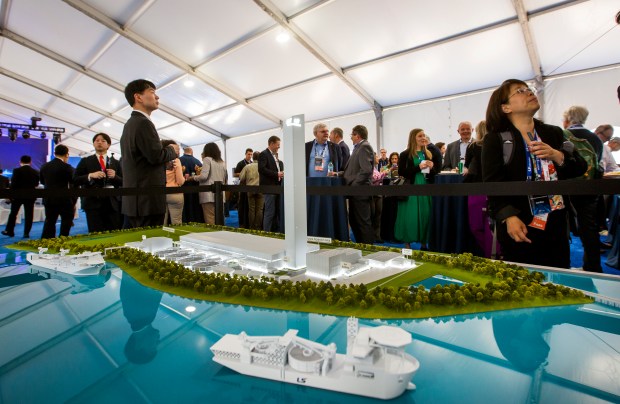A multimillion-dollar underwater cable factory in Chesapeake has officially broken ground, adding another part of the offshore wind supply chain to Hampton Roads.
The 750,000-square-foot plant — part of a $680-million investment by LS Greenlink USA, a subsidiary of South Korean-based LS Cable & System — is expected to create more than 330 full-time jobs. According to public records, LS GreenLink USA purchased the 96.62 acres of land adjacent to the Southern Branch Elizabeth River in Chesapeake from International Bio-Energy Virginia Real Estate LLC for an undisclosed amount. Koo Bon-kyu, president CEO of LS Cable & System, said the plot has “plenty of room to expand” the plant for future phases.
“Years ago, people were talking about Virginia as a victim of sea-level rise or a victim of climate change,” said Sen. Tim Kaine. “Those facts may be accurate, but nobody wants to be the recipient of problems. We want to be the innovator. We want to be the winner. Whether its LS Greenlink here in Chesapeake or the complete electrification of the cranes at the Port of Virginia, … (renewable energy projects) are moving Virginia into a leadership position.”
The plant is expected to be fully operational by the first quarter of 2028. Gov. Glenn Youngkin said the collaboration between economic development officials in Virginia and Chesapeake has been working with counterparts in Korea for years to get the plant to the commonwealth. He approved a $13.2 million grant from the Commonwealth’s Opportunity Fund to assist the city of Chesapeake with the project. The company is eligible to receive state benefits from The Port of Virginia Economic and Infrastructure Development Zone Grant Program. He also said the well-paying jobs will be a good asset to the state’s economy.
The company will also receive $99 million in tax credits from the Inflation Reduction Act of 2022.
“At the beginning of all of this, it took vision,” Youngkin said.

The tower for the facility is expected to be 660 feet. It would be tallest building in Virginia, exceeding the height of the The Westin Virginia Beach Town Center, which stands at 508 feet. In October, the Chesapeake City Council voted unanimously to approve a conditional use permit for the height exception.
The plant’s tower is needed because as the cables are made, gravity helps center the core of the cable. Once produced, the cables are stored in spools and loaded onto ships directly from the pier that’s located on the project site, where they can then be shipped out for offshore wind energy projects across the globe. Koo said many of the company’s first contracts will be for offshore wind projects in Europe.
While the city has no direct influence on recent tariff policy by the Trump administration, Chesapeake Mayor Rick West said he is working on letters and op-eds regarding the issue. Koo said while there is some concern about how tariffs on copper could affect business, the company could adjust pricing on products or take other risk management strategies to address rising costs.
“We’re working very closely with our regional organizations as well as the state of Virginia Economic Development Partnership to truly understand what the impact of tariffs will be,” said Steven Wright, economic development director for the city of Chesapeake. ” At every step along the way, we will try to minimize the impacts (of tariffs) on this project.”
Eliza Noe, [email protected]
